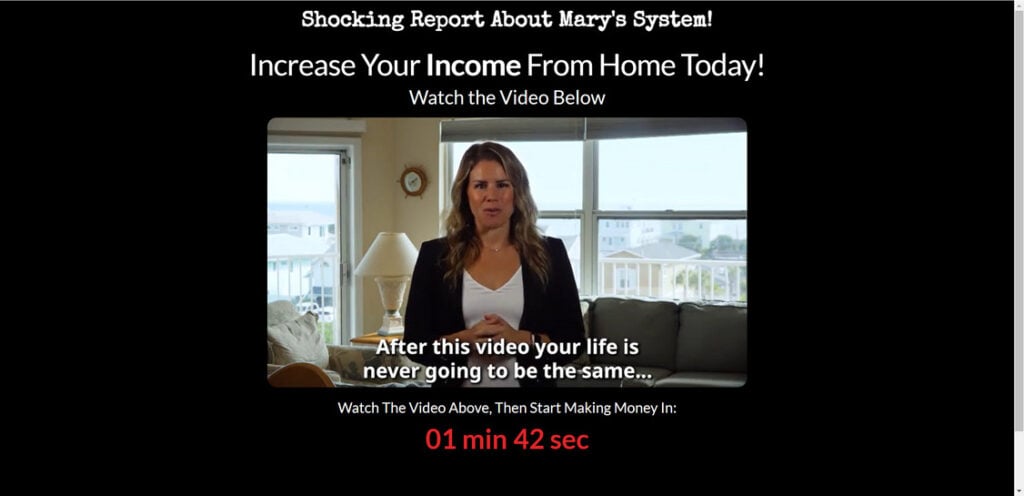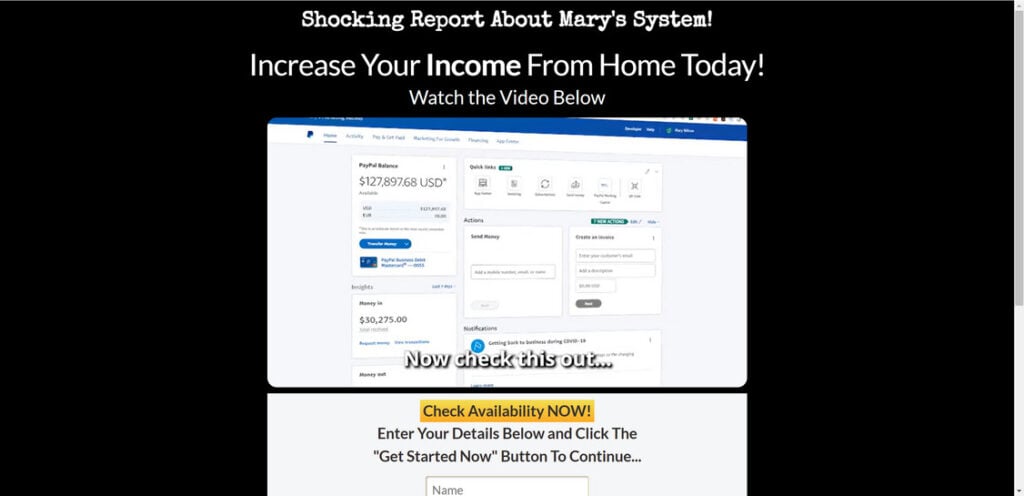The Push Button System advertises itself as an automated way to generate profits by pressing a few buttons. According to the sales pitch, you can rapidly start earning thousands of dollars with minimal effort using their software.
It certainly sounds enticing. But is this system actually legitimate, or is it just a scam designed to siphon money from unsuspecting victims? In this detailed investigation, we’ll examine how the system works, analyze key red flags, and provide tips if you have fallen victim already.
By the end, you’ll have a clear understanding of whether the Push Button System can realistically deliver on its promises of easy automated earnings. Let’s dig in.

Overview: How Push Button System Operates
The Push Button System is marketed as a “set it and forget it” money making program. As the name implies, you supposedly just need to push a button and it will automatically generate profits for you.
Visiting the sales page reveals bold claims of people making thousands or tens of thousands of dollars per day with no prior experience required. Images of expensive cars, boats and mansions reinforce the perception that this system can deliver immense wealth.

To get started, you first need to pay an upfront fee, typically $67. If you attempt to leave the site, they will quickly offer you a “discount” down to $37 to entice you to sign up. This high-pressure tactic creates a false sense of urgency.
After paying, the next step is depositing $250 into a connected brokerage account to “activate” the software. You are led to believe this will enable the automated system to start earning you money rapidly.
In reality, there is no advanced AI or automated trading technology. The system is simply a basic trading platform where you define parameters for trades. There is no concrete proof it can deliver the advertised profits.
The sales page uses additional tricks like fake scarcity claims and countdown timers to create urgency. But there are zero transparency about who owns the system or how it generates endless wealth.
As we’ll explore next, the actual workings of this program point much more to an unethical scam than a legitimate money-making system.
An In-Depth Look at How the Push Button System Scam Works
While the Push Button System is advertised as a miraculous wealth creator, the reality is very different. Here is an in-depth breakdown of how this system operates and why it shows multiple red flags:
Step 1: Landing Page Makes Bold Claims
The first step is getting potential victims onto the Push Button System sales landing page. This page makes wildly exaggerated claims about earning $1,000s per day with no work. Targets are led to believe they can rapidly get rich by paying a small upfront fee.
Various psychological tricks are used on the landing page to persuade visitors. These include:
- Countdown timers
- Limited spots available
- Images of expensive luxury items
- Testimonials from supposed users
In reality, these are false scarcity and social proof tactics with stock imagery. But they create the illusion of exclusivity.
Step 2: Get Users to Pay Initial Fee
Once on the landing page, users are prompted to pay an initial fee to gain access to the money-making software. The advertised price is typically around $67.
However, if you attempt to leave the page, a pop-up will appear instantly that drops the price as low as $37. This makes targets believe they are getting a special deal. In reality, the discounted price was the real fee all along.
This upfront payment gets users invested in the program, making them less likely to question anything moving forward. It also allows the scammers to profit immediately before providing anything of value.
Step 3: Deposit Funds into Brokerage Account
After capturing the initial payment, users are directed to deposit $250 into a trading account connected to the system. This trading account is hosted on a third party platform.
Users are led to believe that this funding is required to activate the software and allow it to start automatically placing profitable trades.
In reality, this money simply goes into the pockets of the scammers. There is no actual advanced trading software as advertised.
Step 4: Discover You’ve Been Scammed
Once the deposit is made, users will be granted access to the system’s trading interface. Very quickly it becomes clear this is NOT an automated money-making software.
Instead, there is simply a bare-bones trading platform where the user has to manually define any trades placed. And inevitably the trades will fail, as no “easy profits” system exists.
At this point victims discover they have been scammed out of the initial fees and deposited funds. The criminals behind the system have already profited handsomely.
No Real Product or Service Provided
Ultimately, the Push Button System does not actually provide any product or service. No working money-making software is given. Just a basic trading interface with no unique technology.
All of the exaggerated claims of easy automated profits are a complete fabrication to trick users into handing over fees and deposited funds.
This is a text-book scam that provides nothing of value. Let’s look at some warning signs that should have been obvious.
5 Big Red Flags of the Push Button System Scam
While scams can be convincing, there were plenty of signs that exposed the Push Button System as an unethical fraud:
1. Claims of easy automated profits – No legitimate trading software can generate consistent profits on complete autopilot. Markets are far too complex for “easy profits” to be realistic.
2. No documented trading strategy – The site failed to explain how their software delivers profits. No trading strategy, technology or proven process was documented.
3. High-pressure sales tactics – Tactics like countdown timers, limited spots available and constantly reducing prices are common tricks used by scammers to create false urgency.
4. Hidden owner identities – The site referenced a creator named “Jay Brown” but this person seems fictional. All registration details were hidden.
5. Overly consistent testimonials – The testimonials didn’t provide enough unique details and were too consistently positive to seem real.
These warning signs made it evident something was amiss. When an offer seems too good to be true, it almost always is.
What to do if You’re the Victim of a Push Button System Scam
If you already paid money to this scam program, don’t panic. Here are some steps to take right away:
- Report the Fraud – File reports with the FTC and BBB to get the scam program on regulators’ radar. The more reports, the better chance of getting it shut down.
- Contact Your Bank – Call your bank and explain you believe you were defrauded. Depending on the timing, charges may be reversed.
- Disconnect Any Accounts – If you connected any payment accounts or gave API access, revoke it immediately in case they try to siphon additional funds.
- Learn From This Experience – Don’t be too hard on yourself. Use this as a learning experience to be more vigilant against scams in the future.
- Spread Awareness – Share your experience with others so they can avoid this scam. Report details to consumer protection groups.
The earlier you act, the better chances you have of recouping losses and protecting others from being defrauded too.
Frequently Asked Questions about the Push Button System Scam
1. What exactly is the Push Button System?
The Push Button System is marketed as an automated trading platform that can generate profits by simply pressing a button. However, it is actually a scam that provides no real trading software or technology. The claims of easy money are false promises designed to trick victims.
2. How does the Push Button System scam work?
The scam works in several steps:
– Visitors are lured to the site with claims of easy automated profits
– They pay an initial fee to “activate” the software
– They are prompted to deposit funds into a connected brokerage account
– Once deposited, it’s revealed there is no real auto-trading software
– The scammers profit from the initial fees and deposited money
3. What techniques does this scam use?
Some of the deceptive techniques include:
– Fake testimonials and images depicting wealth
– Countdown timers and limited spot claims to create false urgency
– Starting with a high fee then dropping to a “discounted” price
– Referencing a fictional owner/creator to seem legitimate
4. What are some red flags of this scam?
Red flags include:
– Claims that seem too good to be true
– No documented trading strategy or technology
– Hidden owner/creator identities
– High-pressure sales tactics
– Claims of easy automated profits
5. What should I do if I already paid this scam?
If you paid fees to this scam, take these steps:
– Contact your bank and report the fraud
– Revoke any connected payment accounts
– File complaints with the FTC and BBB
– Spread awareness about the scam online
– Learn from this experience to spot scams better
6. Can I get my money back if I fell for this scam?
If you act very quickly, you may be able to work with your bank to reverse charges. File detailed fraud reports with any institutions used to pay fees. But the longer you wait, the lower the chances.
7. Are there any legitimate programs for earning automated income?
No programs can genuinely deliver automated income without real work involved. Consistently profiting from markets takes financial knowledge and active effort. Be very wary of any promotions about earning passive profits without real skills or effort.
8. What are some better alternatives for making money online?
Instead of “easy profits” scams, focus your efforts on proven business models like:
– Freelancing
– Consulting
– Selling products/courses
– Affiliate marketing
– Blogging
– Dropshipping
These take work, but can create real incomes by providing value to others.
9. What can I do to avoid online scams in the future?
Be skeptical of “too good to be true” offers, read reviews, research the owners, look for warning signs, and avoid high-pressure sales tactics. Prioritize legitimate skills, experience and value creation.
10. Where can I report this scam to help warn others?
Reporting to the FTC, BBB, and scam reporting groups helps regulators monitor shady programs. Share your experience on review sites and social media to alert fellow consumers. Spreading awareness helps shield more people from financial harm.
The Bottom Line: Don’t Fall for “Get Rich Quick” Scams
The bottom line is the Push Button System displays all of the characteristics of an unethical scam. There is no real trading technology or money-making system provided.
No “easy profits” automated trading system actually exists. Consistently generating returns requires financial knowledge, experience and effort. Any program that claims quick fortunes with little work is highly suspect.
While making money online is possible, building real income takes time and hard work. Focus your efforts on proven business models instead of “get rich quick” scams.
Hopefully this in-depth exposé has provided clarity on how the Push Button System scam works and the warning signs to watch out for. Avoid falling for claims that seem too good to be true. And spread the word to help others from being defrauded.










